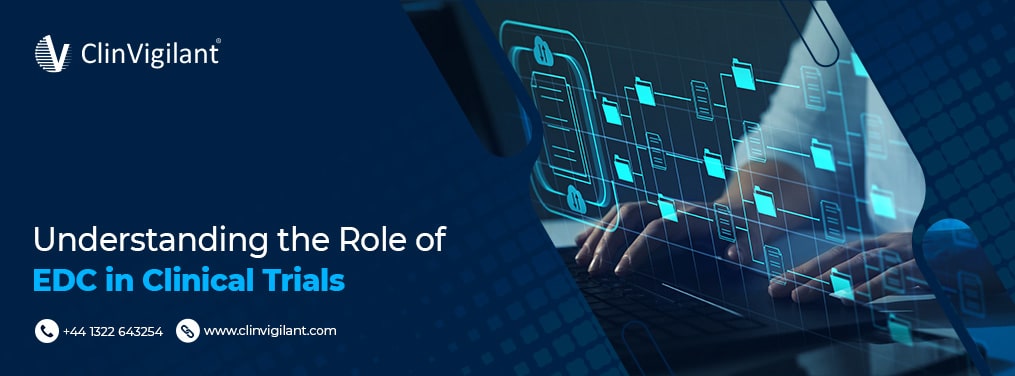
Effective collection, management, and data analysis are integral to producing trustworthy and significant research results in the constantly evolving world of clinical trials. Though traditional paper-based data capture methods have been standard for decades, they carry inherent drawbacks, including increased risk of errors, data inconsistencies, and laborious manual data entry. However, Electronic Data Capture (EDC) has emerged as a novel approach using electronic case report forms (eCRFs), transforming how clinical trial data is collected and managed. This article delves into the pivotal role of EDC in clinical trials, scrutinizing its impact on streamlining the trial process and enhancing data quality, signifying a significant paradigm shift in the research landscape.
What Is EDC in Clinical Trials?
EDC, short for Electronic Data Capture in clinical trials, is used to collect, manage, and store data electronically. It involves using electronic systems, such as specialized software or web-based platforms, to capture and record data generated during a clinical trial. EDC replaces the traditional paper-based case report forms (CRFs) and introduces an efficient and streamlined approach to data collection and management in clinical research.
The electronic case report form (eCRF) is a central component of EDC in clinical trials. An eCRF is a digital equivalent of the paper CRF, which is used to capture and organize data collected during the trial. It consists of electronic forms that mimic the structure and content of the paper CRFs, allowing researchers to enter data directly into the system.
EDC systems offer several advantages over traditional paper-based methods:
- Efficiency: EDC streamlines the data collection process by eliminating the need for manual data entry from paper forms. Researchers can enter data directly into the eCRF during patient visits or assessments, reducing the time and effort required for data transcription.
- Data Quality and Integrity: EDC systems include built-in data validation checks and edit checks, which automatically flag inconsistencies, missing data, or out-of-range values. This helps maintain data accuracy and integrity by minimizing errors during data entry.
- Real-time Data Capture: EDC enables real-time data capture, allowing researchers to enter data immediately during patient visits. This immediate data entry reduces delays and ensures that data is captured promptly.
- Integration of Electronic Source Data: EDC systems facilitate the integration of electronic source data, such as laboratory results, imaging data, or patient-reported outcomes. This integration eliminates the need for manual data entry from multiple sources, reducing errors and ensuring data consistency.
- Data Monitoring and Review: EDC systems provide real-time access to collected data, allowing researchers to monitor data quality, review data trends, and identify any issues promptly. This enables proactive data management and timely resolution of data-related concerns.
- Remote Data Monitoring: EDC systems enable remote data monitoring, eliminating the need for physical presence at the trial site. Monitors and sponsors can remotely access the eCRF, review data, and perform data quality checks, reducing travel costs and saving time.
- Data Security and Compliance: EDC systems prioritize data security and regulatory compliance. They incorporate robust security measures, such as data encryption, user authentication, and audit trails, to ensure the confidentiality and integrity of trial data. EDC systems also support compliance with regulatory guidelines, such as Good Clinical Practice (GCP) requirements.
EDC in clinical trials refers to using electronic systems, including eCRFs, to collect, manage, and store trial data. It offers numerous benefits, including efficiency, improved data quality, real-time data capture, integration of electronic source data, remote data monitoring, and enhanced data security and compliance. EDC has revolutionized how clinical trials are conducted, making data collection and management more efficient, accurate, and streamlined.
Key Benefits of EDC in Clinical Trials
Electronic Data Capture (EDC) has transformed the landscape of clinical trials, offering numerous benefits over traditional paper-based data collection methods. Let’s explore the key advantages of using EDC in clinical trials, emphasizing the benefits of electronic data capture and case report forms (eCRFs).
Enhanced Data Quality and Integrity:
EDC systems incorporate data validation and edit checks, automatically flagging inconsistencies, missing data, or out-of-range values during data entry. These checks improve data accuracy and integrity by minimizing errors associated with manual data entry. EDC also provides real-time data monitoring and review, allowing researchers to promptly identify and address data-related issues.
Real-time Data Capture:
EDC enables real-time data capture, allowing researchers to enter data directly into electronic forms during patient visits or assessments. This eliminates the need for manual transcription from paper forms, reducing errors and delays associated with data entry. Real-time data capture ensures that data is captured immediately, improving efficiency and reducing the chances of data entry errors.
Integration of Electronic Source Data:
EDC systems facilitate the integration of various electronic data sources, such as laboratory results, imaging data, or patient-reported outcomes. By integrating these data sources, EDC eliminates the need for manual data entry from multiple sources, reducing errors and ensuring data consistency. Integration of electronic source data enhances data accuracy and streamlines the overall data collection process.
Streamlined Trial Management and Efficiency:
EDC systems streamline trial management by providing real-time access to data, enabling researchers to monitor trial progress, identify recruitment issues, and make timely decisions regarding study conduct. Remote monitoring capabilities reduce the need for on-site visits, saving time and costs associated with travel. EDC also offers features such as electronic signatures and data transfers, streamlining the data management process and reducing paperwork.
Cost and Time Savings:
EDC systems offer significant cost and time savings compared to paper-based data collection methods. By eliminating the need for paper forms, printing, and manual data entry, EDC reduces administrative tasks and associated costs. Real-time data capture and remote monitoring capabilities save time by providing immediate access to data and reducing the need for physical visits to trial sites.
Data Security and Compliance:
EDC systems prioritize data security and compliance with regulatory requirements. They employ robust security measures, such as data encryption, user authentication, and audit trails, to ensure the confidentiality and integrity of trial data. EDC platforms also support compliance with regulatory guidelines, including Good Clinical Practice (GCP) requirements, by providing tools for electronic signatures, data backup, and secure data storage.
Data Accessibility and Collaboration:
EDC systems enhance data accessibility and facilitate collaboration among researchers, monitors, and sponsors. The centralized nature of EDC platforms allows authorized users to access data from any location, enabling efficient data sharing and collaboration. This promotes transparency, facilitates communication, and supports decision-making throughout the trial.
The Future of EDC in Clinical Trials
Electronic Data Capture (EDC) will transform how clinical research is conducted, and data is managed shortly. As technology plays an increasingly vital role and data management systems advance, EDC is expected to play a pivotal role in shaping the future of clinical trials. Additionally, digitized case report forms (eCRFs) will remain a crucial component of EDC, serving as a digital alternative to traditional paper-based data collection methods. Moving toward electronic data capture will unlock several benefits, including improved accuracy, real-time data capture, enhanced efficiency, and streamlined trial management processes.
In addition, with the constant progression of technology, it is expected that EDC systems will assimilate cutting-edge technologies such as wearable devices, mobile applications, and artificial intelligence. These advancements will pave the way for the capturing of patient-generated data in real-time, remote monitoring, and more engaged participation by patients in clinical trials. The future of EDC in clinical trials harbors the vast potential to hasten the pace of research, enhance data quality, and ultimately culminate in superior patient treatment outcomes.
Conclusion
The implementation of Electronic Data Capture (EDC) in Clinical Trials has revolutionized clinical trials, significantly altering the way data is collected, managed, and analyzed. The adoption of electronic case report forms (eCRFs) through EDC systems has proven to be advantageous when compared to traditional paper-based methods, as it offers accuracy in data and facilitates real-time data capture, streamlined trial management, and improved efficiency. The future of EDC in Clinical Trials holds immense potential with the integration of advanced technologies, allowing for the capture of real-time patient-generated data.
Clinvigilant, a renowned provider of EDC solutions, is one of the most promising platforms in this field. It provides a comprehensive EDC tool suite that guarantees secure data capture, real-time access, and advanced data analysis capabilities. Using Clinvigilant, researchers can streamline their trial processes, elevate data quality, and expedite research speed.

